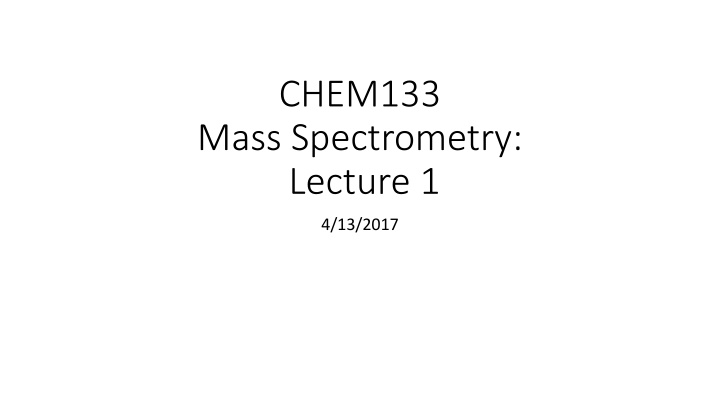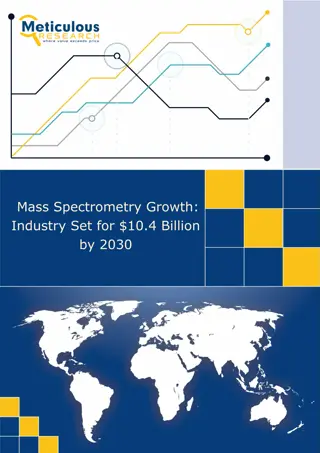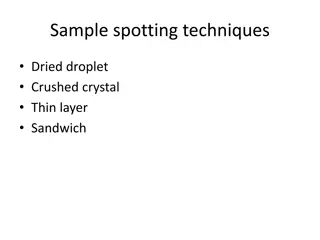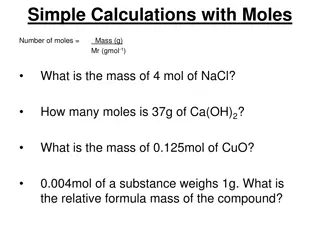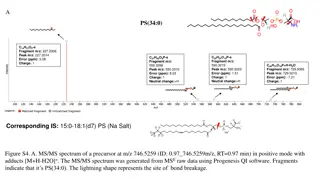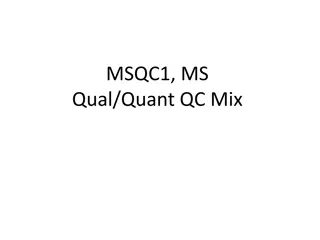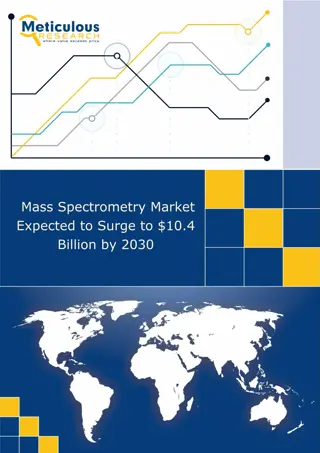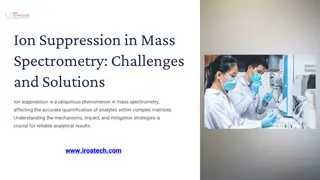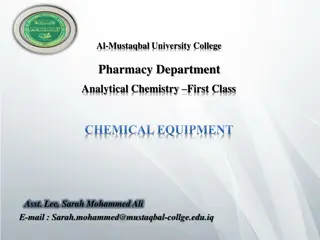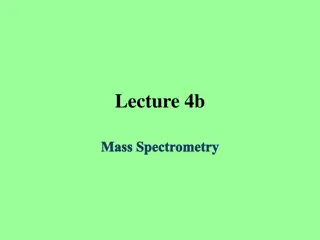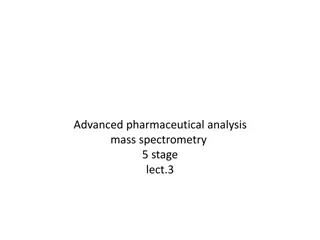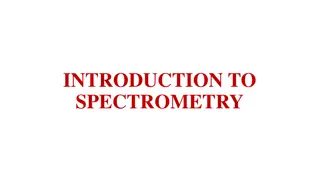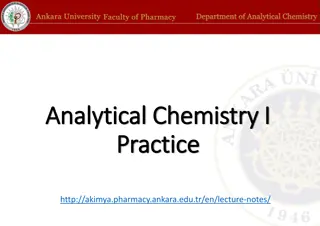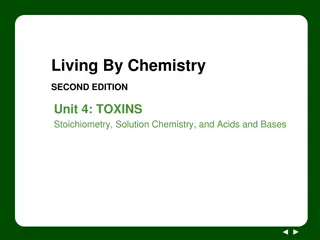Introduction to Mass Spectrometry: Analytical Chemistry Branch
Mass spectrometry is a vital branch of analytical chemistry, used for qualitative and quantitative analysis of molecular weight, elements, and formulas. It plays a crucial role in identifying compounds and their structures through ionization, separation, and detection of ions by utilizing various techniques such as inductively coupled plasma, electron impact, chemical ionization, electrospray, and more. This lecture covers the key components, functions, and applications of mass spectrometry in scientific research and analysis.
Download Presentation

Please find below an Image/Link to download the presentation.
The content on the website is provided AS IS for your information and personal use only. It may not be sold, licensed, or shared on other websites without obtaining consent from the author.If you encounter any issues during the download, it is possible that the publisher has removed the file from their server.
You are allowed to download the files provided on this website for personal or commercial use, subject to the condition that they are used lawfully. All files are the property of their respective owners.
The content on the website is provided AS IS for your information and personal use only. It may not be sold, licensed, or shared on other websites without obtaining consent from the author.
E N D
Presentation Transcript
CHEM133 Mass Spectrometry: Lecture 1 4/13/2017
Announcements Homework 2.2 Additional Problems - Due Quiz Today (after Announcements) 4/18 Lecture will go back to rest of NMR (interpretation examples and instrumentation), then continue on Mass Spectrometry Tokmakoff Lecture (4/20/17, 10-11, Lobby Suite, University Union, 1st Floor) Today s Lecture Mass Spectrometry (Harris Ch. 21)
Mass Spectrometry Introduction One of the Major Branches of Analytical Chemistry (along with spectroscopy, chromatography, and electrochemistry) Roles of Mass Spectrometry Qualitative analysis (less useful than NMR for true unknowns, but can be applied to very small samples) Quantitative analysis (often used for quantitative analysis)
Mass Spectrometry Introduction Main information given in MS analysis: molecular weight number of specific elements (based on isotope peaks) molecular formula (with high resolution MS) reproducible fragment patterns (to get clues about functional groups and/or arrangement of components or to confirm compound identity)
Mass Spectrometry Main Components to Instruments 1. Ionization Source (must produce ions in gas phase) 2. Separation of Ions (Mass Filter) 3. Detection of Ions Note: most common instruments run in order 1 2 3, but additional fragmentation to generate different ions can occur after step 2 (1 2 1 2 3) MS very common as chromatographic detector
Mass Spectrometry Overview of Component Types Ionization Types Type Phase Fragmentation Inductively Coupled Plasma (ICP) Liquid feed Gives elements Electron Impact (EI) gas lots Chemical Ionization (CI) gas some Electrospray (ESI) liquid very little Atmospheric Pressure Chemical Ionization (APCI) liquid some Matrix Assisted Laser Desorption Ionization (MALDI) solid some Desorption Electrospray Ionization (DESI) Portable Very little
Mass Spectrometry Overview of Component Types Separation Types (Ion Filters/Mass Analyzers) Type Speed Basis Cost Magnetic Sector slow Acceleration in magnetic field moderate Double Focusing slow Magnetic plus electric field high Quadrupole fast Passage through ac electric field moderate Ion trap fast Orbit in quadrupole moderate Time-of-Flight very fast Time to travel through tube moderate Newer High Resolution varies Various, usually involving orbits high In addition, there are 2-dimenional MS options (sometimes called MS/MS or tandem MS), such as quadrupole quadrupole, or MSn
Mass Spectrometry Overview of Component Types Detectors Type Internal Amplifications? Uses Faraday Cup Electron Multiplier No Yes Isotope Ratio MS Fairly Common Microchannel plate Yes Higher end instruments Induction No Used in FT-ICR
Mass Spectrometry-GC Ionization (Gas Phase) Electron Ionization (EI), also known as Electron Impact A heated tungsten filament is used to produce electrons which bombard the analyte molecules, causing ionization through loss of an electron (for positive polarity MS): M +e- M(*)+ + 2e- However, M+ typically has extra energy and undergoes further decomposition/fragmentation: M*+ X+ + Y (where X and Y are fragments) We only see the charged fragments, but often if M*+ X+ + Y ,it also may form X + Y+
Mass Spectrometry Ion Source EI Fragmentation Example: + O O C+ charged fragment m/z = 43 (16 + 15 + 12) C + CH3 CH3 charged fragment m/z = 77 (5*13 + 12) O C+ + C CH3 note: stable fragments (77 ion), tend not to greatly fragment
Mass Spectrometry Ion Source Fragmentation Example 2: mass peak at 49 (and 51) CH2Cl2+ CH2Cl+ + Cl - observed CH2Cl + Cl+ mass peak at 35 (and 37) - not observed Presence of ions also depends on their stability (Cl is electronegative so hard to form cation)
Mass Spectrometry Ion Source Gas Phase Sources (cont.) Chemical Ionization (CI) Softer ionization technique Results in less fragmentation Possible in both negative and positive ion modes Initial ionization like EI but in reagent gas methane (+) mode shown below: CH4 + e- CH4+ + 2e- CH4 + CH4+ CH5+ + CH3 CH5++ M MH+ + CH4 major ion typically is M mass + 1
Mass Spectrometry-GC Ionization EI spectrum results in more lower m/z fragments
Mass Spectrometry-HPLC Ionization Electrospray Ionization The HPLC eluent flows through a nebulizer, ions are in this solution (or that are formed in the solution) are guided into the MS region Another soft ionization technique-produces molecular (or M+H+/M-H-) ions Also may produce doubly or greater charged ions (i.e., multiply- charged species), which is more common for larger molecules (i.e., proteins and other biomolecules)
Mass Spectrometry Ion Source Liquid Samples Electrospray Ionization (ESI) Liquid is nebulized with sheath gas Nebulizer tip is at high voltage (+ or ), producing charged droplets As droplets evaporate, charge is concentrated until ions are expelled Efficient charging of polar/ionic compounds, including very large compounds Almost no fragmentation, but multiple charges possible For positive ionization, major peak is M+H peak (most common); or for multiply charged compounds, peak is [M+n]n+ where n = charge on ion For negative ionization, M-1 peak is common Adduct formation also is possible e.g. [M+Na]+ Nebulizing gas High voltage M+H+ + + + + + Liquid in
Electrospray Ionization (ESI)
Mass Spectrometry Ion Source ESI Example: glycodendrimer core (courtesy of Grace Paragas) C30H60N14O12 (sorry, no structure) Mass = 808.451 or for M+H+: 809.459 First Hitachi high resolution ESI-MS sample Full Spectrum M+H+ peak mass error = -2.6 ppm (+/- 5 ppm needed) Internal Standard: used for calibration
Mass Spectrometry Ion Source ESI Example: So if ESI results in no fragmentation, what are the other peaks? 425 peak = (M+H+Na+H2O)/2 M+41 = M+Na+H2O M+H and isotope peaks M+2H/2 peak = (808+2)/2 = 405 13C isotope peaks observed at +1/2 amu
Mass Spectrometry Ion Source DESI Desorption Electrospray Ionization Use of Electrospray focused onto sample to produce ionization Commonly used for remote MS analysis of untreated surface Tip with electrospray is pointed toward sample with vacuum pick up line near by Collisions of electrospray charged drops end up charging surface molecules Resulting ions are picked up to mass spectrometer entrance Electrospray source vacuum line to mass analyzer Mass Analyzer M+ sample Sample plate (electrically conductive)
Mass Spectrometry Ion Source Ion Sources For Liquids (continued) Atmospheric Pressure Chemical Ionization Liquid is sprayed as in ESI, but charging is from a corona needle nearby - More restricted to smaller sized molecules For Solids Matrix Assisted Laser Desorption Ionization Ionization from Laser Samples normally doped with compound that absorbs light strongly (to cause intense heating/ionization)
Mass Spectrometry Ion Source For Elemental Analysis Inductively Coupled Plasma Produces ions as well as atoms used in ICP-AES Most sensitive method of elemental analysis to mass analyzer skimmer cone
Mass Spectrometry Ionization Questions 1. MALDI 2. Which ionization method can be achieved on solid samples (without changing phase)? If one is using GC-MS and concerned about detecting the parent ion of a compound that can fragment easily, which ionization method should be used? CHEMICAL IONIZATION (CI) 3. For a large, polar non-volatile molecule being separated by HPLC, which ionization method should be used? ELECTROSPRAY IONIZATION (ESI, good for larger ionizable analytes) 4. When analyzing a large isolated peptide by ESI-MS, multiple peaks are observed. What is a possible cause for this? MULTIPLE PROTONS ATTACHED TO PEPTIDE 5. What ionization method should be used to analyze for lead (Pb) in a sample? INDUCTIVELY COUPLED PLASMA-Want to reduce analyte/sample to elemental components, single form
